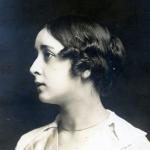
On 17 June the performance of the ballet Giselle is dedicated to the greatest Giselle of XX century Olga Spessivtseva.
In the one-hundred-and-fifty-year history of the ballet Giselle many outstanding dancers throughout the world have added the colouring of their own interpretations to the romantic image of its heroine. But in an associative sense of Giselle being a ballerina, one of the most important names is that of Olga Spessivtseva. Her Giselle at the Mariinsky Theatre in the 1910s and 1920s captivated contemporaries with her “ability to carry with her a sound of the future, a silent tangle of moods” (thus spoke the critic Akim Volynsky of the ballerina in this role). In Paris, which by the 1920s had generally forgotten about this romantic masterpiece which had been created there, Spesivtseva’s interpretation of the role of Giselle in the revival proved ground-breaking and something that was to be copied by an entire generation of performers. And for fans Spessivtseva’s Giselle became a legend. The legend was born not so much from the enthusiastic recollections of audiences and partners of Spesivtseva on the stage as from the tragic events that ran throughout the life of the dancer and the life of her favourite character. The ballerina’s stage life, like the imaginary life of the character, was cut short due to a battle with mental illness. However, the episode of madness concentrated in just a few minutes in the ballet was to last for almost thirty long years in real life.
As a young dancer rehearsing the role of Giselle in St Petersburg Spessivtseva visited a clinic for mental patients and observed their behaviour, getting the gestures and looks just right. The search for the truth in depicting a character was popular at the time she developed as a performer. And that was one of few influences of the time that the ballerina allowed into her life. After graduating from the St Petersburg Theatre School and joining the Mariinsky Theatre in 1913 she witnessed the discoveries of Fokine, but remained un-enamoured with them. In the 1920s, responding to an offer to join Diaghilev’s company, Spessivtseva found herself at the epicentre of artistic experimentation; Balanchine staged a ballet for her but she looked for an excuse not to dance the premiere. Lifar also failed to interest Spessivtseva in new choreography later on in the 1930s at the Opéra de Paris. Olga Alexandrovna Spessivtseva remained true to the classics with which she had fallen in love from her childhood years at the Mariinsky Theatre and performing which ideally suited her elegant and beautifully trained body. Her fully-fledged artistic life only existed in ballets she had learned in Russia before emigrating to the West – Giselle, Swan Lake, The Sleeping Beauty and La Esmeralda. The world had changed, the people around Spessivtseva had changed, and again and again she became Giselle and performed the role of her fateful heroine with ecstasy – first in St Petersburg and later in Europe and America.
And when the eighty-seven-year-old ballerina, then living in a charitable home, cut off from the stage and the world and who had spent two decades in a psychiatric hospital, was visited by her former partner Anton Dolin to make a film about the legendary ballet Spessivtseva remembered how her Giselle had begun, naming those with whom she had danced her most important role. Those close to her had died, glory and fame were in the past, there was no way back to her native land and only Giselle would stay with her forever.
Olga Makarova